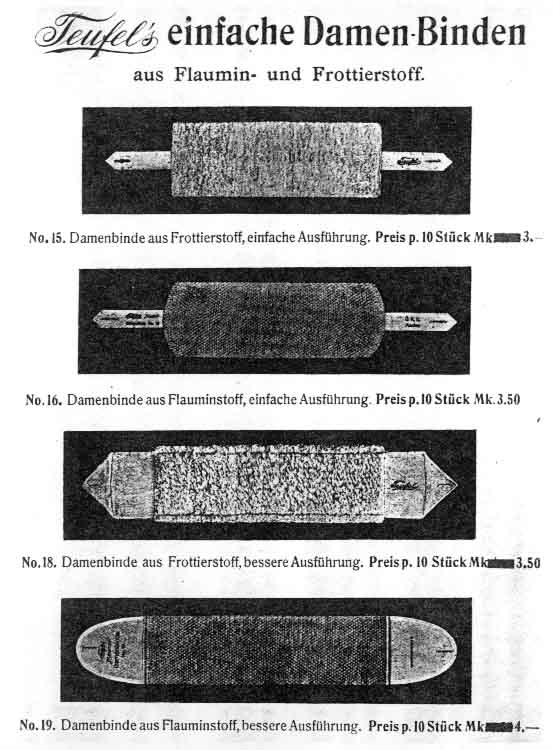|


|

THE MUSEUM OF MENSTRUATION AND WOMEN'S HEALTH
Ads for washable menstrual pads
(Teufel brand of Damenbinden, German
for menstrual pads), about 1900? from
Germany
Women have probably used washable
pads for thousands of years,
washing them rather than throwing them
away, perhaps because of cost and
perhaps because of taboos.
My hunch is that commercial washable
pads first appeared in the 19th
century; women made their own before
then and of course still do today (see
late 19th or early 20th century Japanese and
German
instructions for making them).
Below we see commercial German pads
from about 1900 (see roughly
contemporary Norwegian,
Italian and
American
washable pads, and Japanese pads
from slightly later; and see how a modern pad can trick an Indian
woman's family and neighbors into
giving her more freedom!).
They button
to a holder and
belt, as they also did in the
1930s, even after the German
disposable pad Camelia (introduced in
the 1920s and, sadly, absorbed by
Kotex recently; see an old
and recent
ad) vied for women's Reichsmarks.
Damen
means ladies
and Binde
means bandage.
The U.S.
government classifies patents for
menstrual pads with bandages,
showing a cross-cultural similarity.
And the o.b. in o.b. tampon - a
German brand before Johnson &
Johnson bought it in the 1970s -
stands for ohne Binde, without
a pad,
meaning a tampon. (See an ad from the 1950s and
a later German one, from
the 70s)
By the way, Teufel
means devil
in German, something oddly appropriate
here, although it's undoubtedly the
family name of the manufacturer. In my
13 years in Germany I didn't come
across someone with that name,
however, a tribute to my clean
lifestyle.
(While we're on the subject: Vick's,
the cough drop, etc., in Germany is
spelled Wicks since Germans pronounce
W as the English V. And the
Germans wanted to avoid the "correct"
spelling with V - they would have
pronounced that as Ficks since the
German V sounds like the English F.
Maybe more important is that Ficks is
a German obscenity for sexual
intercourse, almost the English word
except for the second letter.)
The ad is from Junker, Almut and
Stille, Eva.: Zur
Geschichte
der Unterwäsche [Towards a History of
Underwear]. 1700-1960. Eine
Ausstellung des Historischen Museums
Frankfurt 28. April bis 28. August
1988. ; FfM, Germany
(Historisches Museum) 1988, the catalog
of an exhibit of the history of
underwear at the museum of the city of
Frankfurt am Main, Germany.
Unfortunately the catalog does not
tell where the ad appeared; it strikes
me as being from the manufacturer's
catalog - see the last sentence
of the page for Teufel's Diana belts,
which suggests that.
Americans,
suggest to the lady or gent at YOUR
hometown museum that it display
women's underwear and menstrual
gear!! Tell me what she says, if
it's printable without a jail term!
Hey, a Norwegian
town museum
did it, as the did one in Frankfurt!
That'll convince 'em! Those sinful
Europeans!
|
|

|
My
translations of title and
of two items:
Teufel's
simple menstrual pads of
down and terry cloth
No. 15. Terry-cloth
menstrual pad, simple
quality (Damenbinde
is literally ladies'
bandage; bandage is a word
you can see in a menstrual
suspenders ad from
America). Price per
10, 3 marks
No. 19. Down menstrual pad,
better quality. Price per
10, 4 marks
|
|
© 2001 Harry Finley. It is
illegal to reproduce or
distribute work on this Web
site in any manner or medium
without written permission
of the author. Please report
suspected violations to hfinley@mum.org
|
|
|



